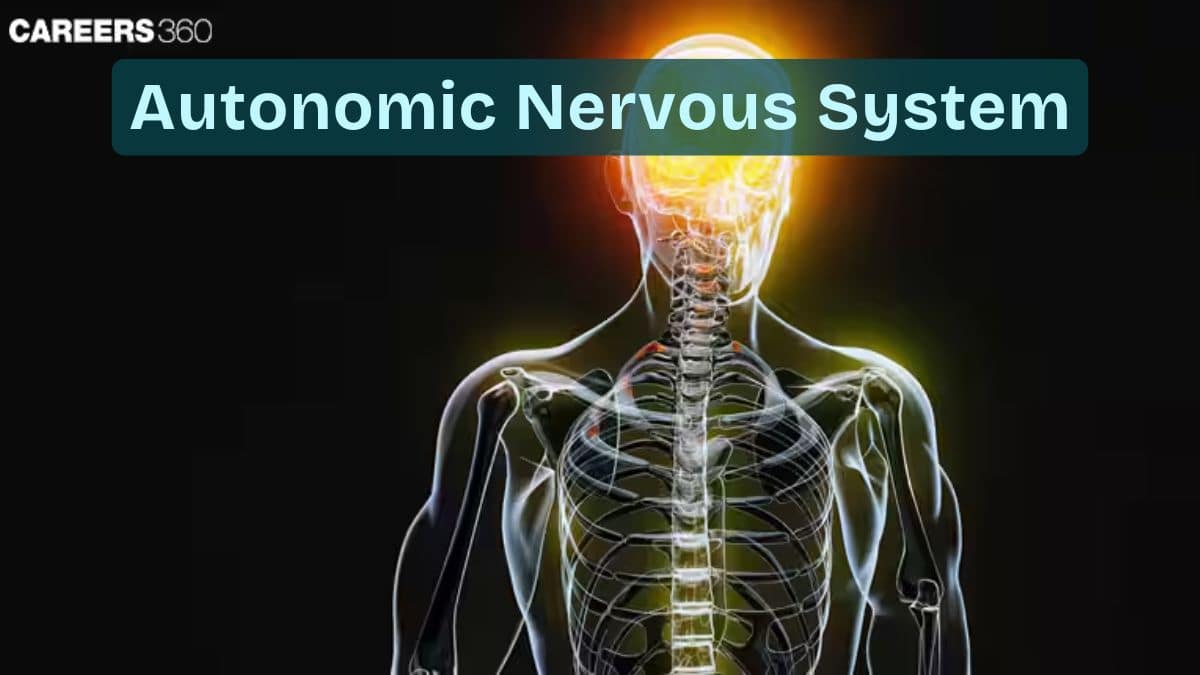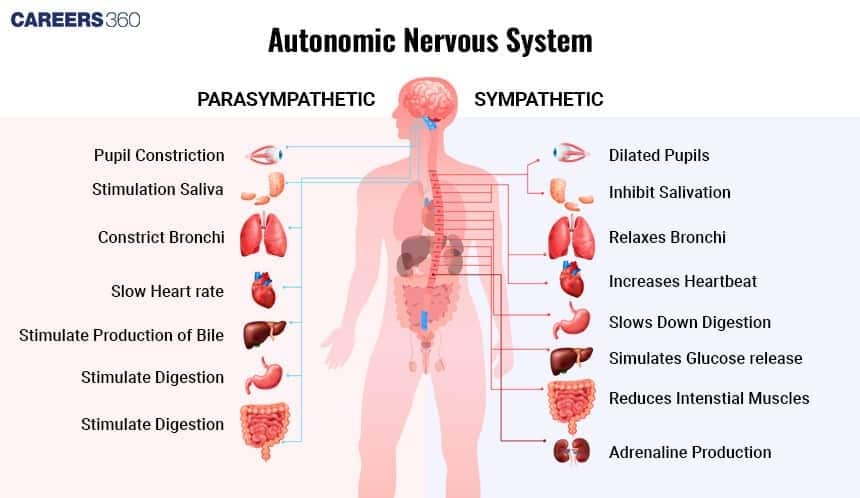Autonomic Nervous System: Divisions, Functions, Anatomy, Function, Disorders
The autonomic nervous system (ANS) operates involuntarily to regulate heart rate, blood pressure, digestion, respiration, and glandular functions. Its sympathetic and parasympathetic divisions work together to maintain homeostasis under stress and rest. This guide explains ANS structure, pathways, functions, disorders, diagrams, NEET MCQs, and exam-focused notes.
This Story also Contains
- What Is the Autonomic Nervous System (ANS)?
- Structure of the Autonomic Nervous System
- Sympathetic Nervous System — Functions
- Parasympathetic Nervous System — Functions
- Enteric Nervous System (ENS)
- Disorders of the Autonomic Nervous System
- Autonomic Nervous System NEET MCQs (With Answers & Explanations)
- Recommended Video on Autonomic Nervous System

What Is the Autonomic Nervous System (ANS)?
The autonomic nervous system is one of the crucial subdivisions of the Peripheral Nervous System. It governs such involuntary activities as heartbeat, blood pressure, digestion rate, and respiratory rate. It runs beneath conscious awareness to maintain homeostasis and to respond to stress.
Two main branches of the ANS are the sympathetic nervous system, which prepares the body for situations concerning 'fight or flight', and the parasympathetic nervous system, leading to 'rest and digest'. These two systems ensure that the body adjusts to various demands but stays balanced within itself.
The autonomic nervous system plays an essential role in homeostasis because it controls most of the fundamental, vital activities in the body subconsciously. It provides prompt responses to stressors and thus maintains survival and optimal organ functions by distributing energy to sustain life processes like circulation, respiration, and digestion.
Structure of the Autonomic Nervous System
The ANS is complex in terms of the anatomical basis of its multiple components and pathways through which it exercises its control over bodily functions. There are two main divisions, along with various neurons and ganglia, that function together to transmit signals.
Division of the ANS
The Sympathetic Nervous System prepares the body for intense physical activity and stress.
The Parasympathetic Nervous System has anabolic predominance for rest and recovery.
Components of the ANS
Preganglionic Neurons: Those originating in the central nervous system that convey the signal to the autonomic ganglia.
Postganglionic Neurons: Receives signals from preganglionic neurons and innervates target organs.
Anatomy of Autonomic Ganglia
Found in various parts of the body, serve as relay stations for nerve impulses.
Enable nerve impulses from the CNS to reach the target organs.

Sympathetic Nervous System — Functions
The sympathetic nervous system is responsible for:
Through vasoconstriction, it redirects blood flow away from the gastrointestinal system and skin.
Peristalsis is inhibited by it.
It improves blood flow to the skeletal muscles and lungs.
By using epinephrine to dilate the bronchioles, it permits increased oxygen exchange in the alveoli.
It increases heart rate and contracts cardiac cells to improve blood flow in the skeletal muscles.
It improves eye vision by relaxing the ciliary muscles and dilation of the pupils.
It dilates the heart's coronary arteries.
The intestinal and urinary sphincters are constricted.
It facilitates sexual response stimulation.
Parasympathetic Nervous System — Functions
The parasympathetic nervous system is responsible for:
By widening the blood arteries, it enhances the flow of blood to the gastrointestinal system.
When oxygen is not required, it constricts the bronchioles.
The heart is parasympathetically controlled by the vagus nerves in the cardiac branches
It allows for closer vision by constricting the pupil and contracting the ciliary muscles.
By activating the salivary glands, it speeds up peristalsis and improves nutrient absorption.
They participate in the erection of genital tissues and increase sexual desire.
Enteric Nervous System (ENS)
The enteric nervous system detects alterations in the gut's chemistry and mechanics. It controls the gut's secretions. It alters the movements of the peristaltic
Disorders of the Autonomic Nervous System
Several disorders and diseases are associated with the ANS. They cause severe health complications.
Dysautonomia
Genetic inheritance, autoimmune diseases, or injury
Major symptoms are fainting, unstable blood pressure, and digestive problems
Diagnosed by autonomic function tests. Medicines and changes in lifestyle for treatment.
Other Disorders of the ANS
Postural Orthostatic Tachycardia Syndrome (POTS): Rapid heartbeat upon standing.
Autonomic Neuropathy: It is the damage to autonomic nerves and it is usually seen in the case of Diabetes.
Autonomic Nervous System NEET MCQs (With Answers & Explanations)
Important questions asked in NEET from this topic are:
Structure of ANS
Functions of Sympathetic and Parasympathetic Nervous System
Practice Questions for NEET
Q1. The nerve centres which control the body temperature and the urge for eating are contained in
Thalamus
Hypothalamus
Pons
Cerebellum
Correct answer: 1) Thalamus
Explanation:
The thalamus is a vital part of the brain with diverse roles beyond its primary function as a sensory relay centre for the visual, auditory, somatosensory, and gustatory systems. It is important for motor activity, emotional regulation, and memory processing.
Hence, the correct answer is option 2) Hypothalamus.
Q2. Select the correct reason why autonomic nervous system is also called visceral or involuntary nervous system
Because the visceral nervous system is a type of autonomic nervous system.
Because it regulate the functions which is in our control
Because it act on visceral organs and regulate involuntary functions
Both 1 and 3
Correct answer: 1) Both 1 and 3
Explanation:
The autonomic nervous system (ANS), also known as the visceral nervous system or involuntary nervous system, is responsible for regulating essential involuntary functions of the body. It supplies nerves to various internal organs such as the blood vessels, heart, smooth muscles, and glands. The ANS plays a crucial role in controlling vital physiological processes, including regulating heart rate, respiratory rate, urinary output, body temperature, and other autonomic functions. It operates automatically, without conscious control, and is divided into two main branches: the sympathetic and parasympathetic nervous systems, which have opposing effects to maintain homeostasis.
Hence the correct answer is option 4) Both 1 and 3.
Q3. The organ of corti is a structure present in
External ear
Middle ear
Semi-circular canal
Cochlea
Correct answer: 4) Cochlea
Explanation:
The organ of Corti is present at the sensory ridge present at the basilar membrane which is present in the cochlea. The Organ of Corti contains specialized hair cells that act as auditory receptors, converting sound vibrations into nerve impulses. These hair cells are topped with stereocilia, which move in response to fluid displacement caused by sound waves. This movement is transduced into electrical signals, which are then transmitted to the brain via the auditory nerve for sound perception.
Hence, the correct answer is option 4) Cochlea.
Also Read:
Recommended Video on Autonomic Nervous System
Frequently Asked Questions (FAQs)
Treatments include medications, changes in lifestyle and physical therapy, and, in some cases, alternative therapies like biofeedback.
The autonomic nervous system controls involuntary functions, such as the rate of heartbeats, digestion rate, respiratory rate, etc. It maintains homeostasis.
The sympathetic system prepares the body for 'fight or flight' responses and the parasympathetic system prepares it for 'rest and digest' activities.
Common disorders include Dysautonomia, Postural Orthostatic Tachycardia Syndrome, and Autonomic Neuropathy.
These range from autonomic function testing and heart rate variability tests to tilt table testing in some cases.